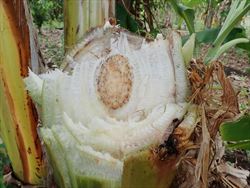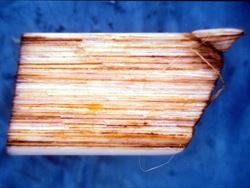- Narrow. Indonesia and Malaysia. Not recorded in Oceania.
- Major bacterial disease of banana - Musa acuminata, Musa bulbisiana, their hybrids, and Musa textalis. ABB and BBB cooking bananas especially susceptible. Information lacking on wild hosts.
- Symptoms vary depending on source of infection:
- (i) from soil : leaves yellow, wilt, collapse, and die. Internally, reddish-brown vascular staining, and white/yellow/red or black ooze.
- (ii) from flowers: fruit stem is invaded, flowers blacken, bell rots, fruits have internal rots, but remain green, and vascular tissues darken. Infections reach the corm, then leaf sheaths, and leaves turn brown, wilt and die.
- Spread: infected suckers, in soil, water, root-to-root contact; by insects (visiting male and female flowers); by pruning knives; from discarded infected fruit; mud on machinery/vehicles. Survival in soil for >1year.
- Biosecurity: risk is from unofficial introduction of diseased cuttings for propagation; possibly infected fruit; risk also from mud on vehicles. Official movement of germplasm should always follow the FAO/IPBGR Technical Guidelines.
- Biocontrol: none.
- Cultural control: take cuttings from apparently healthy plants, ideally from government scheme (if exist); avoid planting near diseased bananas; limit visitors/animals/workers to plantations; weed; remove male ‘bell’ after last hand emerges; bag flowers; clean tools frequently after use (bleach); remove diseased plants immediately, and contain spread with trench, leaving area fallow for 18 months or grow legume cover crop; clean soil from machinery/vehicles. Use local knowledge to select resistant varieties.
- Chemical control: not a method to use.
Pacific Pests, Pathogens and Weeds - Online edition
Pacific Pests, Pathogens, Weeds & Pesticides
Banana blood disease (522)
Blood disease. It is also known as blood disease bacterium of banana.
Ralstonia syzygii subsp. celebesensis; previously, it was known as Pseudomonas celebesensis, Pseudomonas sp. nr. solanacearum. There is similarity to Ralstonia solanaciarum (moko and bugtok), although the blood disease bacterium is considered to be of different origin. In a new classification system based on molecular analysis, Ralstonia syzygii is in Phylotype IV (Indonesian) on origin and evolution. The abbreviation is BDB.
AUTHOR Grahame Jackson
Information from Drenth A, Kema G (2021) The vulnerability of bananas to globally energing disease threrats. Phytopathology 111: 2146-2161; and Blood disease (2018) NSW Department of Primary Industries. NSW Government; Eden-Green SJ (1994) Musa Disease Fact Sheet no. 3. International Network for the Improvement of Banana and Plantain, Parc Scientifique Agropolis, 34397 Montpellier Cedex 5, France; and Blomme G, et al. (2017) Bacterial diseases of banana and enset: Current state of knowledge and integrated approaches toward sustainable management. Frontiers in Plant Science. (https://www.frontiersin.org/articles/10.3389/fpls.2017.01290/full#B66); and Davis RI, et al. (2001) Blood disease and panama disease: two newly introduced and grave threats to banana production on the island of New Guinea. In: Proceedings of the Papua New Guinea Food and Nutrition 2000 Conference, PNG University of Technology, Lae, 26–30 June 2000. ACIAR Proceedings No. 99, xviii + 892p.; and CABI (2019) Blood disease bacterium (blood disease bacterium of banana. Crop Protection Compendium. (https://www.cabi.org/cpc/datasheet/46702); and FreshPlaza. Banana blood disease poised to spread throughout Southeast Asia. (https://www.freshplaza.com/article/9384862/banana-blood-disease-poised-to-spread-throughout-southeast-asia/); and Ray JD, (2021) Geographic expansion of banana blood disease in southeast Asia. Plant Disease. The American Phytopathological Society. (https://apsjournals.apsnet.org/doi/10.1094/PDIS-01-21-0149-RE); and from Drenth A (2020) Reversing the impact of Banana blood disease in Indonesia. APBSF Project Final Report PBSF016: 22pp. (http://www.apbsf.org.au/wp-content/uploads/2020/06/PBSF016-Drenth-Banana-Blood-Disease-Final-Report.pdf). Photos 1-5 Jane Ray, Centre for Horticultural Science, The University of Queensland, Brisbane, QLD 4001, Australia. Photo 6 Davis RI, Liberato JR (2006) Banana blood disease (Blood disease bacterium). PaDIL - http://www.padil.gov.au.
Produced with support from the Australian Centre for International Agricultural Research under project HORT/2016/185: Responding to emerging pest and disease threats to horticulture in the Pacific islands, implemented by the University of Queensland, in association with the Pacific Community.
*The codes ABB and BBB are determined by the proportion of Musa acuninata and Musa bulbisiana (original species) represented in any variety. An internationally recognised scoring system is used to determine the proportion.









